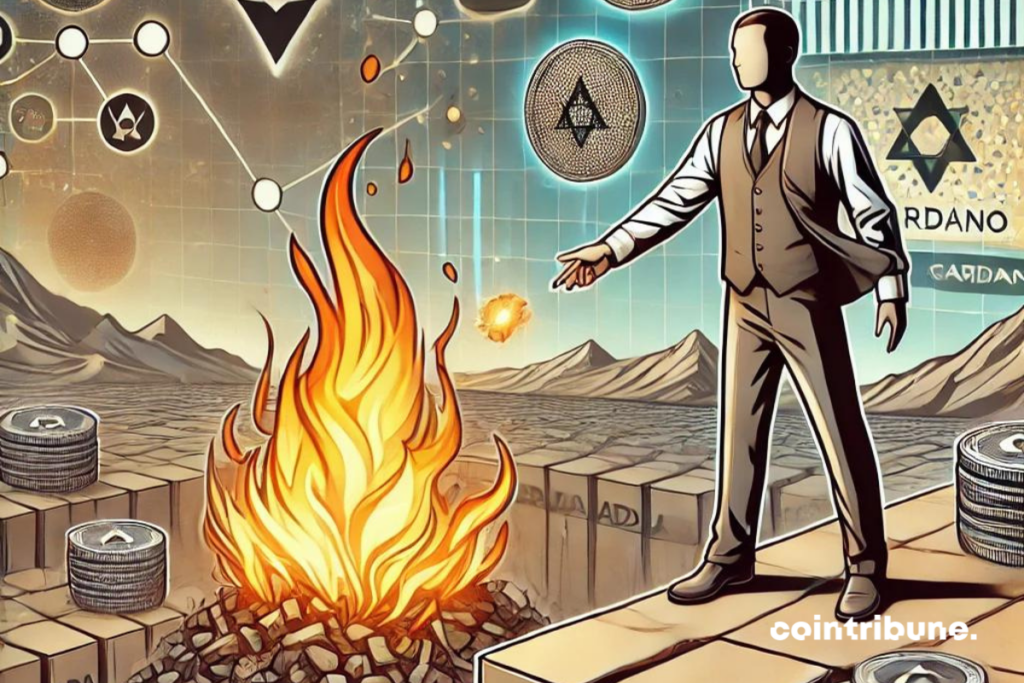Cardano : HOSKINSON rejects the burning of ADA cryptocurrencies !
The proposal to burn 1.5 billion ADA tokens is currently causing controversy within the crypto community. Charles HOSKINSON, founder of Cardano, has taken a stand against this controversial idea. In the midst of decentralized governance, this proposal to destroy these ADA tokens raises questions on various levels, both economic and ethical.

HOSKINSON denounces a “confiscation” of treasury tokens
On September 5, Charles HOSKINSON, via a post on X, firmly expressed his opposition to the proposal to burn the 1.5 billion ADA tokens from Cardano’s treasury, estimated at around $500 million. For him, this initiative is akin to outright theft. “You are literally stealing from every staking pool operator (SPO) and every ADA holder if you burn these funds“, he said. HOSKINSON emphasizes that these tokens are not “pre-printed” assets but come from block production and economic activities of the network. In other words, their destruction would harm Cardano’s internal economy.
This stance comes at a time when Cardano has just completed the first phase of its Chang hard fork, which established a fully decentralized governance system. The destruction project was initiated in this context by community members who aim to use these new powers to radically change the structure of the treasury. However, the proposal is divisive. Some believe this initiative could boost the price of the ADA token. Detractors, like HOSKINSON, argue that it would weaken the ecosystem in the long run.
Alternatives to burning to strengthen the ecosystem
In the face of HOSKINSON’s opposition, other voices are rising to propose alternatives to the destruction of the treasury tokens. Jaromír TESAR, one of the decentralized representatives (DReps) of Cardano, believes that burning these funds would be a “terrible mistake”. In his view, the 1.5 billion ADA could be reinvested in the development of the ecosystem. “We could fund new Catalyst projects, inject liquidity into DeFi, or accelerate the development of scalability technologies”, he said. He also mentioned the idea of using these funds to integrate USDC and USDT stablecoins on the Cardano blockchain or to strengthen the project’s marketing efforts.
It is clear that Cardano’s future now rests on the decisions of its decentralized governance. While some hope that the token burn will boost the price of ADA, others fear a decrease in the investment capacity of the network. The question is whether some of the blockchain’s resources should be sacrificed for short-term benefit, or used to strengthen Cardano’s competitiveness against other competitors.
If decentralized governance paves the way for new possibilities, it also exposes the community to crucial choices for the network’s future. The implications of such a gesture could be vast, whether it involves temporarily boosting the token’s value or compromising long-term development capabilities. More than ever, the ADA community will need to weigh the pros and cons and keep Cardano’s sustainability and growth objectives in mind.
Maximize your Cointribune experience with our "Read to Earn" program! For every article you read, earn points and access exclusive rewards. Sign up now and start earning benefits.
Diplômé de Sciences Po Toulouse et titulaire d'une certification consultant blockchain délivrée par Alyra, j'ai rejoint l'aventure Cointribune en 2019. Convaincu du potentiel de la blockchain pour transformer de nombreux secteurs de l'économie, j'ai pris l'engagement de sensibiliser et d'informer le grand public sur cet écosystème en constante évolution. Mon objectif est de permettre à chacun de mieux comprendre la blockchain et de saisir les opportunités qu'elle offre. Je m'efforce chaque jour de fournir une analyse objective de l'actualité, de décrypter les tendances du marché, de relayer les dernières innovations technologiques et de mettre en perspective les enjeux économiques et sociétaux de cette révolution en marche.
The views, thoughts, and opinions expressed in this article belong solely to the author, and should not be taken as investment advice. Do your own research before taking any investment decisions.